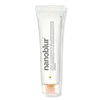What's inside
What's inside
 Benefits
Benefits

 Concerns
Concerns

 Ingredients Side-by-side
Ingredients Side-by-side

Water
Skin ConditioningAdipic Acid/Neopentyl Glycol Crosspolymer
Dimethicone
EmollientGlycerin
HumectantCyclopentasiloxane
EmollientVp/Va Copolymer
Cyclohexasiloxane
EmollientPhenoxyethanol
PreservativeAmodimethicone
Hydroxypropyl Methylcellulose
Emulsion StabilisingSodium Acrylate/Sodium Acryloyldimethyl Taurate Copolymer
Emulsion StabilisingCaprylyl Glycol
EmollientIsohexadecane
EmollientPolysilicone-11
Polysorbate 80
EmulsifyingCitric Acid
BufferingWater, Adipic Acid/Neopentyl Glycol Crosspolymer, Dimethicone, Glycerin, Cyclopentasiloxane, Vp/Va Copolymer, Cyclohexasiloxane, Phenoxyethanol, Amodimethicone, Hydroxypropyl Methylcellulose, Sodium Acrylate/Sodium Acryloyldimethyl Taurate Copolymer, Caprylyl Glycol, Isohexadecane, Polysilicone-11, Polysorbate 80, Citric Acid
Water
Skin ConditioningDimethicone
EmollientGlycerin
HumectantEthylhexyl Palmitate
EmollientButylene Glycol
HumectantCetyl PEG/PPG-10/1 Dimethicone
EmulsifyingPentaerythrityl Tetraethylhexanoate
EmollientC30-45 Alkyl Dimethicone
Skin ConditioningIsohexadecane
EmollientDipropylene Glycol
HumectantPEG/PPG-18/18 Dimethicone
EmulsifyingMagnesium Sulfate
Phenoxyethanol
PreservativeCaprylyl Glycol
EmollientDimethiconol
EmollientSodium Palmitoyl Proline
Skin ConditioningSodium Benzoate
MaskingCentella Asiatica Extract
CleansingSodium Carboxymethyl Beta-Glucan
CleansingCitric Acid
BufferingNymphaea Alba Flower Extract
Skin ConditioningWater, Dimethicone, Glycerin, Ethylhexyl Palmitate, Butylene Glycol, Cetyl PEG/PPG-10/1 Dimethicone, Pentaerythrityl Tetraethylhexanoate, C30-45 Alkyl Dimethicone, Isohexadecane, Dipropylene Glycol, PEG/PPG-18/18 Dimethicone, Magnesium Sulfate, Phenoxyethanol, Caprylyl Glycol, Dimethiconol, Sodium Palmitoyl Proline, Sodium Benzoate, Centella Asiatica Extract, Sodium Carboxymethyl Beta-Glucan, Citric Acid, Nymphaea Alba Flower Extract
Ingredients Explained
These ingredients are found in both products.
Ingredients higher up in an ingredient list are typically present in a larger amount.
Caprylyl Glycol is a humectant and emollient, meaning it attracts and preserves moisture.
It is a common ingredient in many products, especially those designed to hydrate skin. The primary benefits are retaining moisture, skin softening, and promoting a healthy skin barrier.
Though Caprylyl Glycol is an alcohol derived from fatty acids, it is not the kind that can dry out skin.
This ingredient is also used as a preservative to extend the life of products. It has slight antimicrobial properties.
Learn more about Caprylyl GlycolCitric Acid is an alpha hydroxy acid (AHA) naturally found in citrus fruits like oranges, lemons, and limes.
Like other AHAs, citric acid can exfoliate skin by breaking down the bonds that hold dead skin cells together. This helps reveal smoother and brighter skin underneath.
However, this exfoliating effect only happens at high concentrations (20%) which can be hard to find in cosmetic products.
Due to this, citric acid is usually included in small amounts as a pH adjuster. This helps keep products slightly more acidic and compatible with skin's natural pH.
In skincare formulas, citric acid can:
While it can provide some skin benefits, research shows lactic acid and glycolic acid are generally more effective and less irritating exfoliants.
Most citric acid used in skincare today is made by fermenting sugars (usually from molasses). This synthetic version is identical to the natural citrus form but easier to stabilize and use in formulations.
Read more about some other popular AHA's here:
Learn more about Citric AcidDimethicone is a type of synthetic silicone created from natural materials such as quartz.
What it does:
Dimethicone comes in different viscosities:
Depending on the viscosity, dimethicone has different properties.
Ingredients lists don't always show which type is used, so we recommend reaching out to the brand if you have questions about the viscosity.
This ingredient is unlikely to cause irritation because it does not get absorbed into skin. However, people with silicone allergies should be careful about using this ingredient.
Note: Dimethicone may contribute to pilling. This is because it is not oil or water soluble, so pilling may occur when layered with products. When mixed with heavy oils in a formula, the outcome is also quite greasy.
Learn more about DimethiconeGlycerin is already naturally found in your skin. It helps moisturize and protect your skin.
A study from 2016 found glycerin to be more effective as a humectant than AHAs and hyaluronic acid.
As a humectant, it helps the skin stay hydrated by pulling moisture to your skin. The low molecular weight of glycerin allows it to pull moisture into the deeper layers of your skin.
Hydrated skin improves your skin barrier; Your skin barrier helps protect against irritants and bacteria.
Glycerin has also been found to have antimicrobial and antiviral properties. Due to these properties, glycerin is often used in wound and burn treatments.
In cosmetics, glycerin is usually derived from plants such as soybean or palm. However, it can also be sourced from animals, such as tallow or animal fat.
This ingredient is organic, colorless, odorless, and non-toxic.
Glycerin is the name for this ingredient in American English. British English uses Glycerol/Glycerine.
Learn more about GlycerinIsohexadecane is added to enhance texture, emulsify, and to help cleanse. It is an isoparrafin. It is a component of petrolatum.
Due to its large size, Isohexadecane is not absorbed by the skin. Instead, it sits on top and acts as an emollient. Emollients help keep your skin soft and smooth by trapping moisture within.
Isohexadecane is often used in products designed to help oily skin. It is lightweight and non-greasy while helping to moisturize. When mixed with silicones, it gives a product a silky feel.
Learn more about IsohexadecanePhenoxyethanol is a preservative that has germicide, antimicrobial, and aromatic properties. Studies show that phenoxyethanol can prevent microbial growth. By itself, it has a scent that is similar to that of a rose.
It's often used in formulations along with Caprylyl Glycol to preserve the shelf life of products.
Water. It's the most common cosmetic ingredient of all. You'll usually see it at the top of ingredient lists, meaning that it makes up the largest part of the product.
So why is it so popular? Water most often acts as a solvent - this means that it helps dissolve other ingredients into the formulation.
You'll also recognize water as that liquid we all need to stay alive. If you see this, drink a glass of water. Stay hydrated!
Learn more about Water